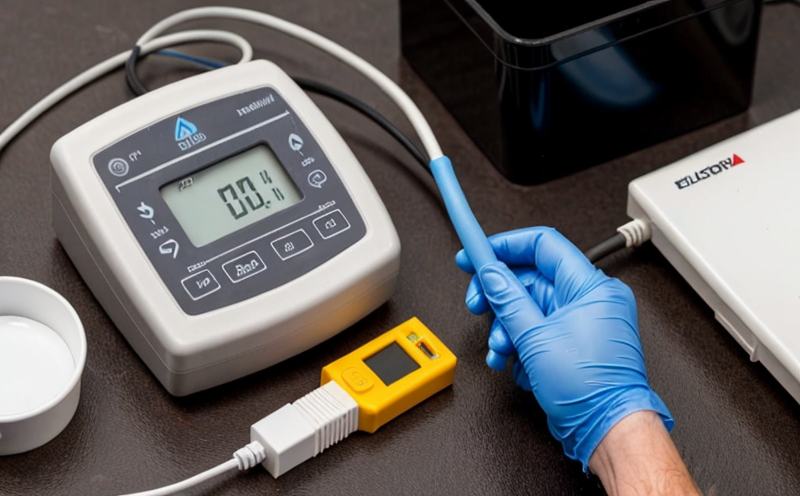CFR 40 Electrochemical Testing of Hazardous Wastewater
The U.S. Code of Federal Regulations (CFR) Title 40, Part 40, regulates the standards and methodologies for testing various environmental samples, including hazardous wastewaters. This service focuses on providing comprehensive electrochemical analysis that adheres to CFR 40 requirements. Our laboratory specializes in ensuring accurate and reliable determination of parameters such as pH, conductivity, dissolved oxygen (DO), redox potential, and other critical indicators.
Evaluating these parameters is crucial for industries dealing with hazardous wastewaters, as it helps them comply with stringent environmental regulations set forth by the Environmental Protection Agency (EPA). Electrochemical testing involves measuring electrical properties of a solution to infer chemical conditions. This method is highly sensitive and can provide real-time data on wastewater quality.
Our team conducts thorough preparation of samples, ensuring they are representative of the actual waste stream. Once prepared, we use advanced electrochemical instruments like potentiostats, voltammetry setups, and cyclic voltammetry systems to perform precise measurements. The results obtained from these tests provide valuable insights into the nature of hazardous components present in the wastewater.
The testing process involves several key steps:
- Sampling: Collection of representative samples from various points within the wastewater system.
- Preparation: Dilution or concentration adjustments based on sample characteristics to ensure accurate readings.
- Instrumentation Setup: Calibration and configuration of electrochemical instruments according to ASTM D6432-12.
- Data Acquisition: Recording measurements under controlled conditions.
- Analysis: Interpretation of data against CFR 40 standards for compliance verification.
The accuracy and precision of our tests are paramount. We employ rigorous quality control measures at every stage, from sample collection to final reporting, ensuring that all results meet the stringent requirements set by CFR 40. This includes maintaining traceability to international standards like ISO/IEC 17025 for laboratory competence.
Our approach ensures not only compliance with regulatory mandates but also supports ongoing R&D efforts aimed at improving wastewater treatment processes and reducing environmental impact. By leveraging our expertise in electrochemical testing, we help clients make informed decisions regarding process optimization and pollution prevention strategies.
| Parameter | CFR 40 Compliance Requirement | Testing Methodology |
|---|---|---|
| pH | Must be within specified limits for waste classification | Potentiometric measurement using pH meters calibrated per ASTM D6432-12 |
| Dissolved Oxygen (DO) | Must meet specific thresholds based on wastewater characteristics and treatment plant design | Electrochemical reduction of dissolved oxygen with subsequent potentiometry |
| Redox Potential | Indicates the oxidizing or reducing nature of the environment, crucial for certain waste classifications | Cyclic voltammetry to assess potential shifts in redox states |
Quality and Reliability Assurance
We understand that reliability is essential when dealing with hazardous wastewaters. Our laboratory adheres strictly to ISO/IEC 17025 standards, ensuring that all tests are conducted under controlled conditions with minimal variability. Regular internal audits and external reviews further reinforce our commitment to quality.
Our technicians receive continuous training on the latest methodologies and technologies associated with electrochemical testing. This ensures they remain up-to-date with any changes in regulatory requirements or industry practices. Additionally, we maintain state-of-the-art equipment that undergoes regular calibration and maintenance schedules to uphold accuracy levels.
Data integrity is maintained through robust quality assurance protocols, including:
- Standard Operating Procedures (SOPs) for each test procedure
- Duplicate sample analysis to verify consistency of results
- Comprehensive documentation supporting every step of the testing process
These measures ensure that clients receive not only reliable data but also peace of mind knowing their compliance efforts are robustly supported.
International Acceptance and Recognition
Our electrochemical testing services for hazardous wastewaters are recognized globally, with our results being accepted by regulatory bodies worldwide. Compliance with CFR 40 standards is particularly important for multinational corporations operating across different regions, as it ensures uniformity in environmental practices regardless of location.
The acceptance of our test results extends beyond mere compliance; they also contribute to the credibility of the company's environmental management systems (EMS). By demonstrating adherence to international standards like ISO 14001, firms can enhance their reputation and gain competitive advantages. Furthermore, these certifications facilitate smoother interactions with stakeholders including regulators, investors, and clients.
Our services play a vital role in supporting various sectors such as pharmaceuticals, petrochemicals, chemical manufacturing, and wastewater treatment facilities. In industries where environmental responsibility is paramount, accurate and reliable electrochemical testing helps maintain high standards of operation while fostering sustainable practices.
Use Cases and Application Examples
Evaluating hazardous wastewaters using CFR 40-compliant electrochemical tests serves multiple purposes across different industries. Here are some practical applications:
- Pollution Prevention: Early detection of pollutants allows for proactive interventions to prevent environmental harm.
- Treatment Optimization: Continuous monitoring helps fine-tune treatment processes, enhancing efficiency and effectiveness.
- Compliance Verification: Regular testing ensures that facilities are meeting legal requirements consistently.
- Risk Management: Identifying potential risks early through electrochemical analysis aids in developing effective mitigation strategies.
| Industry Sector | Potential Impact of Testing |
|---|---|
| Pharmaceuticals | Detecting trace amounts of contaminants to prevent ecological damage. |
| Petrochemicals | Monitoring for harmful substances that could affect local ecosystems. |
| Chemical Manufacturing | Avoiding hazardous leaks and spills by constant vigilance over waste streams. |





